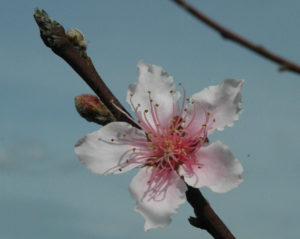Peaches transition to offer more markets for farmers, variety for consumers
Writer: Kathleen Phillips, 979-845-2872, [email protected]
Contact: Dr. David Byrne, 979-845-9500, [email protected]
COLLEGE STATION — Used to be, a peach was a peach. But now consumers choose between combinations of sweet, tangy-sweet, round, flat, yellow flesh or white flesh, to name a few, all readily available at grocery stores.
More importantly for peach producers, however, is that new varieties are being bred to yield well in the more southern parts of Texas and the U.S., which previously were too hot for the trees to fruit, according to Dr. David Byrne, professor of Rosa and Prunus Breeding and Genetics for Texas A&M AgriLife Research, College Station.
“When I came to Texas in 1983, there were only yellow peaches produced commercially,” Byrne said. “That’s the traditional peach here, and they are fine. But after looking at markets in other places, I realized Texas peach growers probably needed more than the traditional variety to sell.

“That was the whole idea behind my breeding program since, and as a result, there are about 20 new varieties now offering a variety of traits.”
Byrne hopes his long-term strategy now provides growers with an opportunity to expand acreage across the state.
Texas peaches were historically grown in the more northern parts of the state because the traditional varieties needed a large number of “chill hours,” or period of time with cold temperatures in the winter, in order to set fruit. That limited production potential statewide.
Texas’ planted acreage has fallen in recent years from 6,000 acres some 20 years ago to about 3,000 commercial acres in 2016, according to the U.S. Department of Agriculture-National Agriculture Statistics Service. And despite its $9.2 million value in the state, the Texas crop has not landed in the top 10 peach-producing state rankings for years.
Acreage also has gradually fallen nationwide, according to the United Nations-Foreign Agriculture Service, from about 81,000 in 1994 to almost 51,000 acres in 2014.
Despite the 50 percent decrease in Texas peach acreage, overall yield has dropped by only 20-25 percent, Byrne said.
“This indicates that the acreage left is in better operations that have been able to withstand the wild swings in productivity caused by late spring frosts and warm winters,” he said.
Byrne said reasons for the drop in acreage is not understood, as the fruit continues to be popular with consumers. But he believes breeding varieties that can withstand warmer temperatures and still produce fruit will help the crop stabilize and increase. Also, the probability of spring frosts decreases further south in the state where the lower chill peach varieties can be grown.
“My goal has been to develop varieties that will help growers regain some of that value, especially in local markets,” he said.
In addition to focusing on breeding tree varieties that required fewer chill hours, Byrne said, he developed the low acid, sweeter White Delight line, and higher acid and tangy but sweet White Zest line for their exotic color.
Next, he selected for flat shapes using germplasm he got from Chinese colleagues beginning in the late 1980s and early 1990s.
“In China, where the peach originated, it used to be only the emperor who could eat the flat or donut-shaped peaches. That is how valuable and special they were,” Byrne said. “Now they are available to all people.”
Byrne also added nectarines to his research project, breeding for medium- and low-chill traits as well as high acid and subacid flavors.
“It takes 12-18 years to develop each variety, so now that these have been available for a few years, people are beginning to grow them more and more,” he said. “We’re getting good reports on the usefulness of these varieties.”
Another idea for commercial growers is to mix the type of trees they grow for different chill requirements, Byrne said, so that whether winter temperatures in an area are relatively high or low, at least a portion of the orchard will likely yield fruit.
“The production in Texas is more variable from year to year than any other state, and the major reasons are spring frosts and the amount of winter chilling received,” Byrne said. “This year, for example, the number of chilling hours received was very low overall, so very few of the traditional varieties in the northern area fruited. But my varieties (with low chill requirements) fruited well.
“If a grower has these in the orchard for low chill years and uses frost protection because they bloom earlier than the traditional varieties, they should have more consistent production.”
He said the varieties are released to nursery companies for propagation for commercial orchards and backyard plantings and are increasingly becoming more available for purchase.





